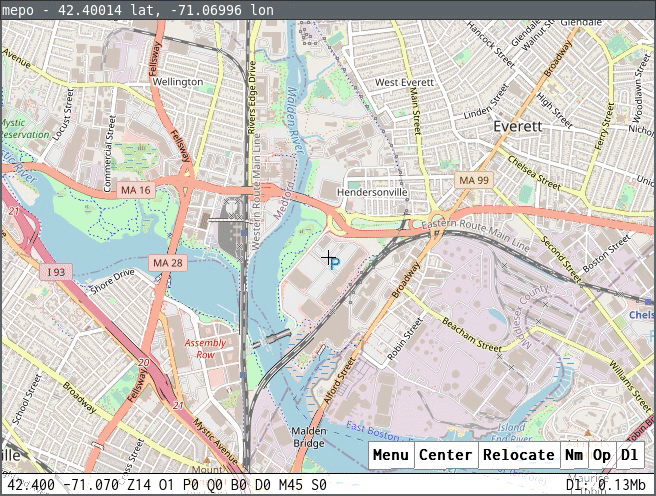Mepo is a fast, simple, hackable OSM map viewer for mobile and desktop Linux! Free your navigation now.

Mepo is a fast, simple, and hackable OSM map viewer for desktop & mobile Linux devices (like the PinePhone, Librem 5, postmarketOS devices etc.) and both environment's various user interfaces (Wayland & X inclusive). Environments supported include Phosh, Sxmo, Plasma Mobile, desktop X, and desktop Wayland. Mepo works both offline and online, features a minimalist both touch/mouse and keyboard compatible interface, and offers a simple & powerful JSON API to allow the user to change & add functionality such as adding their own search & routing scripts, add arbitrary buttons/keybindings to the UI, and more.
Get started now:
Features
- Fast & usable in resource-constrained environments:
- Mepo launches quickly and runs quickly on the PinePhone and other resource-constrained devices.
- Mepo renders using SDL which keeps things fast and lightweight; also as a bonus: portable.
- Built in a non GC'd language (Zig) with an aim toward careful memory usage and allocations/deallocations
- Simple JSON API for Scripting & Extending:
- Mepo's core UI is built out to be as minimal as possible, only handling map rendering, displaying, pins, and simple IO operation (keybinding, mouse callbacks, etc.)
- Extendeded functionality such as menus & and search integrations (via Nominatim, Overpass), routing (via Mobroute and GraphHopper), and similar are built out utilizing Mepo's extensible JSON API
- The JSON API allows you to
- Reposition the map, change tileserver, etc.
- Change preferences
- Create arbitrary buttons to run other API commands
- Create arbitrary keybindings to run other API commands
- Inject pin data onto the map
- Modify pin "groups" to collect sets of pins together
- Create custom user scripts (in any language of your choosing outputting JSON)
- And more
- Offline operation as a first-class feature:
- Downloading of maps for later offline use can be done non-interactively through a command-line flag.
- Users can download based on a bounding-box or a user-specified radius from a specific point for multiple zoom levels.
- Offline usage is a primary usecase and should be treated as such, we can't assume a user is always online.
- Supports touch AND keyboard-oriented operation:
- A map application must of course be usable with a mouse / touch, but the keyboard as a tool for map navigation has been overlooked in in map applications.
- Provides vi-like (& customizable) keybindings out-of-the-box.
- Should be usable in touch-oriented environments like the PinePhone and similar where a physical keyboard isn't present.
- Compatible across multiple Linux mobile environments including: Phosh, Plasma Mobile, Sxmo, and Swmo. Being written in SDL ensures good support and portability to other future environments as well.
